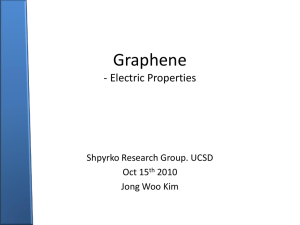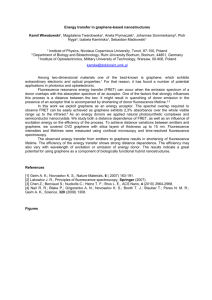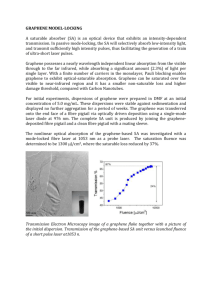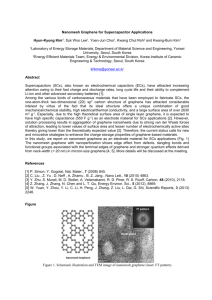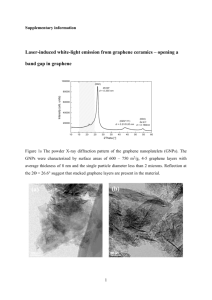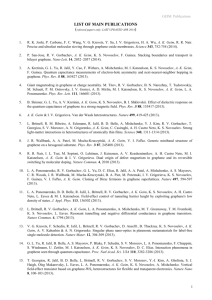Graphene - Dancing on Thin Ice
advertisement
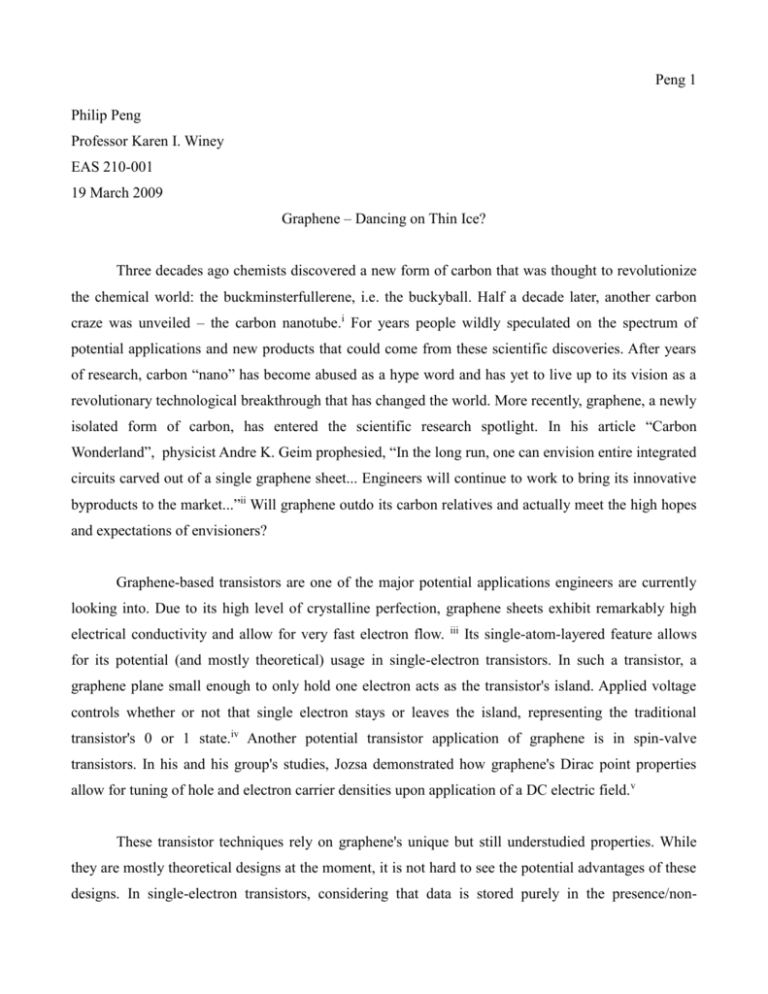
Peng 1 Philip Peng Professor Karen I. Winey EAS 210-001 19 March 2009 Graphene – Dancing on Thin Ice? Three decades ago chemists discovered a new form of carbon that was thought to revolutionize the chemical world: the buckminsterfullerene, i.e. the buckyball. Half a decade later, another carbon craze was unveiled – the carbon nanotube.i For years people wildly speculated on the spectrum of potential applications and new products that could come from these scientific discoveries. After years of research, carbon “nano” has become abused as a hype word and has yet to live up to its vision as a revolutionary technological breakthrough that has changed the world. More recently, graphene, a newly isolated form of carbon, has entered the scientific research spotlight. In his article “Carbon Wonderland”, physicist Andre K. Geim prophesied, “In the long run, one can envision entire integrated circuits carved out of a single graphene sheet... Engineers will continue to work to bring its innovative byproducts to the market...”ii Will graphene outdo its carbon relatives and actually meet the high hopes and expectations of envisioners? Graphene-based transistors are one of the major potential applications engineers are currently looking into. Due to its high level of crystalline perfection, graphene sheets exhibit remarkably high electrical conductivity and allow for very fast electron flow. iii Its single-atom-layered feature allows for its potential (and mostly theoretical) usage in single-electron transistors. In such a transistor, a graphene plane small enough to only hold one electron acts as the transistor's island. Applied voltage controls whether or not that single electron stays or leaves the island, representing the traditional transistor's 0 or 1 state.iv Another potential transistor application of graphene is in spin-valve transistors. In his and his group's studies, Jozsa demonstrated how graphene's Dirac point properties allow for tuning of hole and electron carrier densities upon application of a DC electric field.v These transistor techniques rely on graphene's unique but still understudied properties. While they are mostly theoretical designs at the moment, it is not hard to see the potential advantages of these designs. In single-electron transistors, considering that data is stored purely in the presence/non- Peng 2 presence of a single electron as opposed to a charged/uncharged state in typical metal–oxide semiconductor field-effect transistors (MOSFETS), it has the potential to not only be faster but also require less energy to operate. The simplicity of the design and non-bulk components allows for plenty of room for miniaturization with Geim optimistically predicting transistors of less than 10 nanometers across – easily satisfying Moore's Law.vi In Jozsa's group's research, graphene allowed for changing the field effect transistor's spin valve signal by as much as ±50%.vii Jozsa also noted that the ability to maintain strong control over the electron's drift velocity would allow for improvements in other transistor designs that use p-n junctions.viii While the potential of these new technologies certainly look good on paper, will they revolutionize the marketplace in the near future? Judging from the current production situation and the historical success of graphene's carbon cousins, Geim is likely to be disappointed. As of the moment, graphene manufacturing techniques are still far from effective or reliable and far from being commercially viable. At a price of over $1000 for a micromechanically cleaved graphene crystallite smaller than the thickness of a human hair ix, mass production is out of question. Single-electron transistors and other forms of transistor designs that would theoretically use graphene over silicon or other conventional materials would be scrapped on a cost-effectiveness basis. Geim's “entire integrated circuit carved out of a single graphene sheet” may easily outperform an equally-sized modern equivalent, but the cost of production could possibly pay for hundreds of modern equivalents that, combined, outperforms Geim's circuit many-folds. Why not just find better and cheaper manufacturing processes then? Decades after their discovery, methods of producing carbon nanotubes and buckyballs are still relatively expensive and inconsistent. The electronics industry has already poured billions of dollars into perfecting the silicon manufacturing process and is unlikely to be willing to spend billions more in new and different technology that may potentially only provide marginal improvements. While graphene transistors show immense promise, the cost factor is currently just far too high. Will graphene-based transistors ever be found on the standard computer? Maybe. Saying no would be overly pessimistic but anyone betting on a near future of thin graphene would be dancing on thin ice. Word count: 788 Peng 3 Works Cited Geim, Andre K. et al, “Carbon Wonderland.” Scientific America. April 2008. Jozsa C. et al, “Electronic spin drift in graphene field effect transistors.” University of Groningen. 14 May 2008. 15 Mar. 2009. <http://dissertations.ub.rug.nl/FILES/faculties/science/2008/n.tombros/08-c8.pdf>. Geim, Andre K. et al, “Carbon Wonderland.” Scientific America. April 2008. 92 Geim 97 Geim 94 Geim 96 Jozsa C. et al, “Electronic spin drift in graphene field effect transistors.” University of Groningen. 14 May 2008. 15 Mar. 2009. <http://dissertations.ub.rug.nl/FILES/faculties/science/2008/n.tombros/08-c8.pdf>. 104 vi Geim 97 vii Jozsa 104 viii Jozsa 112 ix Geim 97 i ii iii iv v
